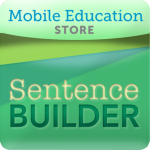ABC Tracing: Free app
This app is for students who are learning to write and recognize the alphabet. They are able to trace upper and lower case letters with their finger. To erase, you touch the eraser and shake the device. There is an audio component for each letter and object. It’s very simple and goes directly to the app with no distracting homepage. Graphics are clear and not busy or confusing. I would choose this app for one of my students who has difficulty with fine motor skills. He doesn’t know all his letters and often reverses letters (such as b and d).
Colourful Aquarium: Free app
This is an app of a realistic aquarium with beautiful fish. They can feed the fish with food. Students can clean the moss that grows over time. Students can also scare away the fish. The app is meant to make the viewer relax. When I first saw this app I instantly thought of one my students who carries a lot of anger. He will often become very upset, cry and hit himself. He will also use a lot of negative talk. Perhaps this app would lessen or even alleviate the escalation. I think this app would be a gentle distraction for him. It might help calm him down.
ABC Pocket Phonics: Cost $2.99
This app focuses on emergent readers and how they acquire phonics skills. As students learn the letter sounds; the app guides them on how to write each letter. It also teaches letter sounds that come from combining letters together (like ‘ch’ and ‘sh’). The app reinforces letter/sound association. This app would work well with students who are struggling in both reading and writing. Students experiencing auditory processing difficulties would also benefit from this app.
Sentence Builder: $3.99
This app is designed to help students learn how to build grammatically correct sentences. It’s simple to use and has three levels to play. It has encouragement animations and audio clips. The Sentence Builder lets students build sentences by selecting from a group of words. It has images where students must choose the words that match with what they see in the picture. This app would be great for ESL students. It would assist in familiarizing ESL students with the structure of a sentence along with general vocabulary.
Pictello: $14.99
This app enables students to make their own storybooks with pictures imported in or taken with the built in camera. This is a powerful tool in creating meaningful stories. Students can write their personal stories and hear their stories read by a narrator or they can record themselves. It’s easy to use and is designed for all ages and all skill levels. Students who are non-verbal would have a wonderful opportunity to share their stories to the world through their choice of pictures and text. ESL students would also be able to create stories where they could experiment with the English language. If they feel confident enough they can record their own voices, if not the narrator can do it for them. Pictello is not a free app and the price does seem a bit steep. But, I think it’s really worth the price.
StoryBuilder for iPad 5.99
Story Builder is designed to help children improve paragraph formation and to integration of ideas. Extensive use of audio clips promotes improved auditory processing for special needs children with autism spectrum disorders or sensory processing disorders. It provides a fun way for students to create a writing narrative. It also allows students to record their own voice reading the narrative. There are 50 story lines to choose from and once complete stories can be saved and emailed. I would use this for at risk writers in the elementary or junior high level.
Social Skills $3.99
Social Skills offers parents and educators the ability to interact with six social narratives (broken into 2 levels which give a total possible of 12 social narratives) designed to help individuals improve their social ability. The stories contain targeted instruction in the following core areas: Joint Attention; Non-Verbal Communication; Greetings; Structured game play; Turn Taking; Classroom rules; and Imitation.The other great part is users can create their own stories by adding different photos, text, as well as audio. The end results allows for the individual to look at a social photo, touch the picture for audio, and continue onto the next page!
Sight Words List - Learn to Read Flash Cards & Games - Free!
Sight Words, also known as the Dolch List are an integral part in learning how to read. The Dolch Word list contains 315 words that are broken down into appropriate age groups. It is important for young readers to be able to instantly recognize these high frequency words in order to be proficient and fluent readers. As a bonus you can also create your own personalized word list. I would use this for any age student who is having trouble with reading or writing especially have difficulty remembering their high frequency words.
Storycubes- $1.99
For this app they give your around 6 cubes that are like dice and you give them a shake. On the cubes are pictures such as a sunshine or and animal. You have to take the cubes and be able to tell a story using all of the cubes. This would be reat for story starters, reluctant writers, speaking and listening, creative writing. Love them
Tumblebooks: $5.99
Those of you that have used Tumblebooks online will already be familiar with it. Now they are available as an app and include animations. You can purchase many of your favorite children's author books in packs of six. Great for reluctant readers and young grades for read alouds and reading responses.









